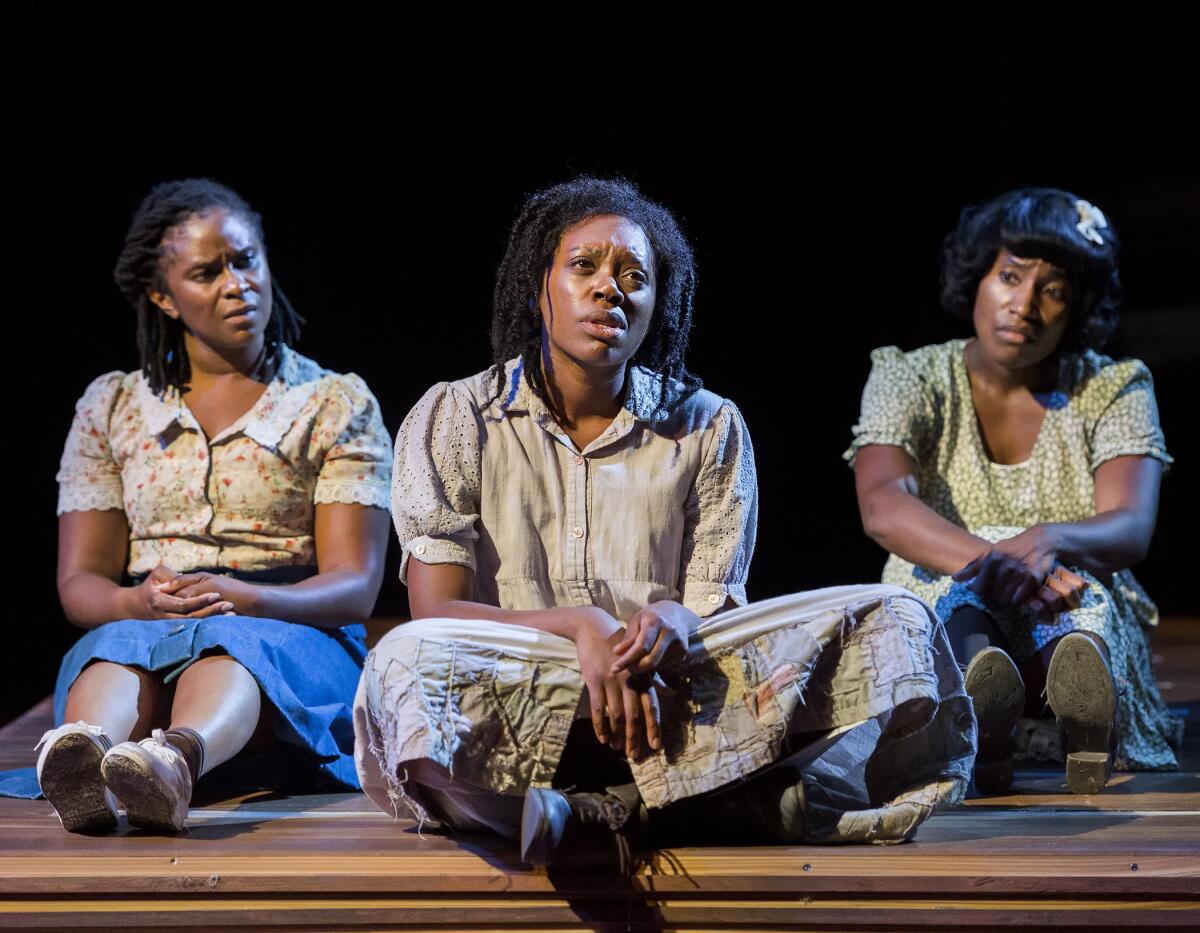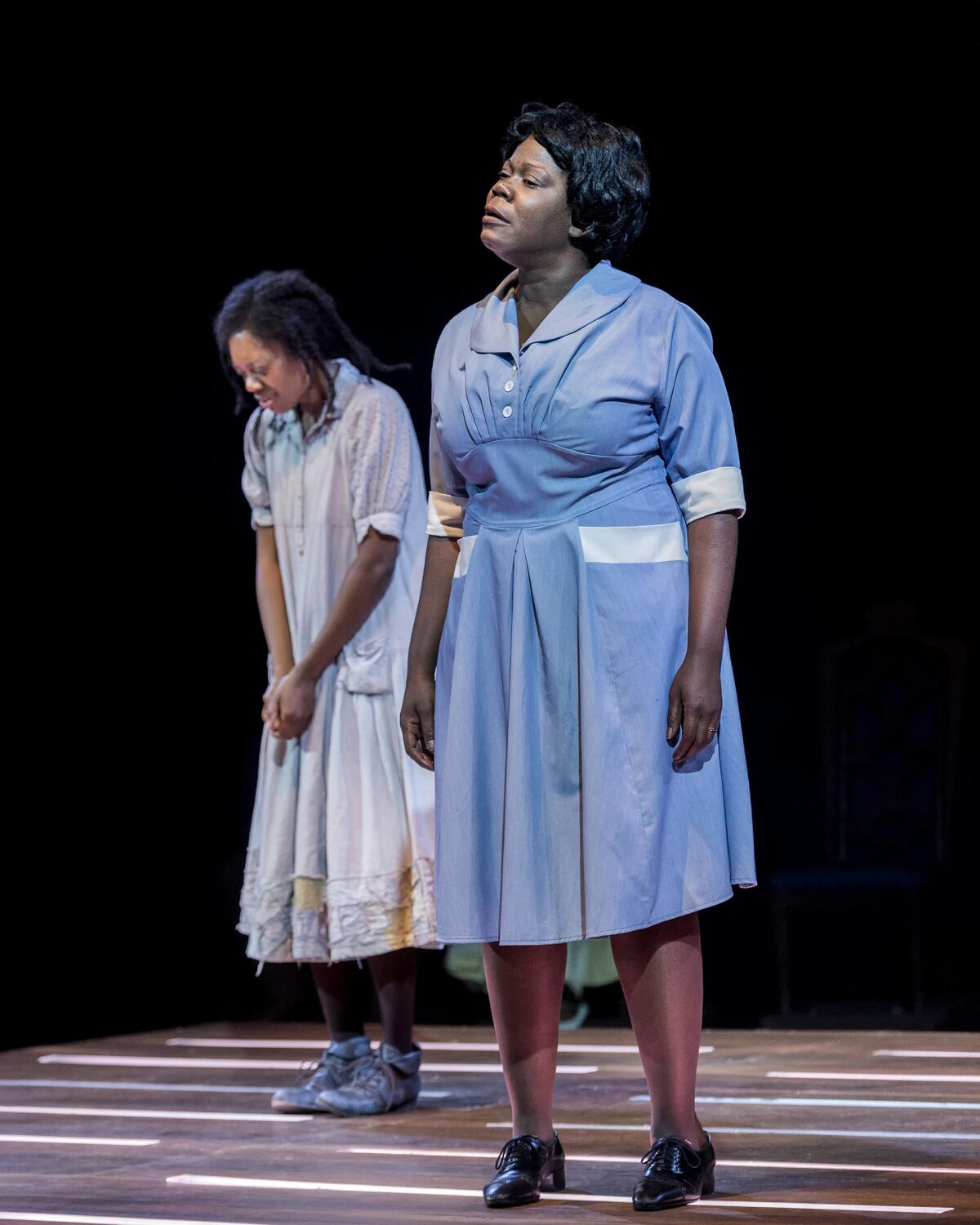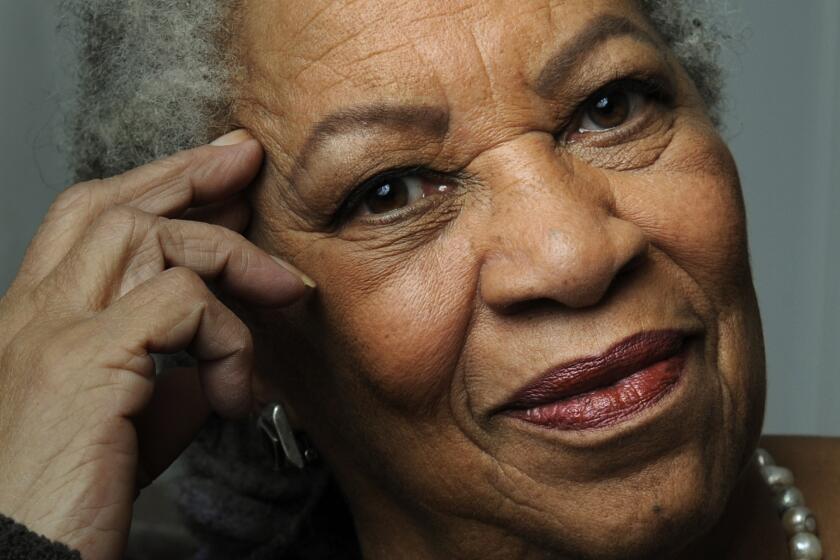Review: Toni Morrison’s unflinching wisdom guides a propulsive ‘The Bluest Eye’ at A Noise Within

- Share via
The unflinching wisdom of Toni Morrison lends not only purpose but propulsion to the stage adaptation of her first novel, “The Bluest Eye,” now at Pasadena’s A Noise Within through Sept. 24.
Morrison conceived her story in novelistic form, jumping freely between past and present. Playwright Lydia R. Diamond’s dramatization doesn’t force the book into a dramatic formula. Instead, she respects the fluidity of the story and maintains an openness of form that allows director Andi Chapman to summon the essence of the novel to powerful life onstage.
“The Bluest Eye” tells the story of a friendship, of sorts, between preteen schoolgirls, two sisters and a fellow student whose home life is tumultuous. Pecola’s self-worth is irreparably damaged by the abuse she suffers from a society bearing racist standards of beauty that have made her feel like an unlovable human being. This retrospective tale, a work of memory, is largely set in 1940s Ohio.
Toni Morrison, the author, essayist and winner of Nobel and Pulitzer prizes, famously encouraged would-be writers to take action.
Claudia (Kacie Rogers) and her sister Frieda (Mildred Marie Langford) have been asked to welcome Pecola (Akilah A. Walker) into their home after Pecola’s house burned down. Pecola’s parents are always fighting. Her mother, Mrs. Breedlove (a powerful Julanne Chidi Hill) has run out of patience with her husband, Cholly (Kamal Bolden), who lies about the house all day in a drunken stupor and is unpredictably abusive.
The outside world is no more welcoming to Pecola. Everybody seems to recoil from this young woman, who is dark-skinned, and she has internalized the rejection. She prays for God to give her blue eyes, believing that if she looked like Shirley Temple, she would be treated with loving kindness instead of indifference.
Not even the neighborhood grocer will acknowledge her hello when she comes into his store to buy her favorite candy. Claudia, who serves as narrator (ably handled by Rogers), annotates the moment for us: “It’s a total absence of human recognition, a glazed separateness right behind his eye. Pecola has seen interest, disgust, even anger in grown male eyes. But this vacuum has an edge. An edge of distaste that lurks in the eyes of all white people. The distaste is for her Blackness.”
Claudia and Frieda are remembering Pecola to trace what happened to their lonely, ostracized friend who was impregnated by her alcoholic father. Claudia knows that before the why of the story can be considered, the how must be chronicled in all its seemingly tangential yet crucially relevant details.

“The Bluest Eye” traces insidious racism in the interpersonal sphere with microscopic focus. Morrison connects the dots between the casual dismissal of a Black girl in a grocery store and a mother’s rejection of her daughter, whose face reminds her too much of her own.
The play, like the book, proceeds in scenes of harsh, unforgettable vividness. One scene is devastating not only in its psychological cruelty but also in its forensic analysis of how the poison of white supremacist thinking trickles down.
We’ve already witnessed the girls at school confronting Maureen (Alexandra Metz), the pretty, light-skinned girl whose superficial friendliness only thinly conceals arrogant privilege and superiority. But when Pecola shows up with Claudia and Frieda at the house where her mother works, the hierarchies of race and class come crashing down on her.
Pecola is taken aback not only by the wealth and abundance of this white family that employs her mother but also by the care her mother provides the white child who is represented onstage by a creepy doll. After Pecola accidentally knocks over the glorious blueberry pie her mother prepared for the family, her mother scolds her mercilessly, upsetting the white child, whom Mrs. Breedlove comforts as she would never comfort her own child.
Who were those girls, the white child fearfully asks. “Nobody” is the annihilating reply.
The production asks us to commune with Morrison’s radioactive words and insights, to reckon with the story in a public forum. Schools have been banning the book, but those making such bone-headed decisions should be forced back to school to receive the education that apparently never took the first time around.
I read the novel again shortly after Morrison’s death in 2019 and I was grateful for another encounter with this American classic, lacerating as it can be in its resolute truthfulness. Experiencing “The Bluest Eye” with an audience forces a different kind of reckoning. There is no hiding from the societal shame of Pecola’s story.
The episodic nature of the work protracts the ending. But then Pecola’s unfortunate story is permitted no relief. Exploitation and manipulation follow abuse. Walker’s performance preserves Pecola’s trusting innocence. The world repeatedly tells her no, but she still turns her face in hopeful expectation that one day she’ll be greeted with compassionate humanity.
'The Bluest Eye’
Where: A Noise Within, 3352 E. Foothill Blvd., Pasadena
When: 8 p.m. Fridays, 2 and 8 p.m. Saturdays, 2 p.m. Sundays. (Check for exceptions.) Ends Sept. 24.
Tickets: Start at $29
Contact: anoisewithin.org or (626) 356-3100
Running time: 1 hour, 45 minutes (no intermission)
Tarell Alvin McCraney, Geffen Playhouse’s new artistic director, discusses the “calling” of theater and his vision for the future of the Westside theater.
More to Read
The biggest entertainment stories
Get our big stories about Hollywood, film, television, music, arts, culture and more right in your inbox as soon as they publish.
You may occasionally receive promotional content from the Los Angeles Times.













